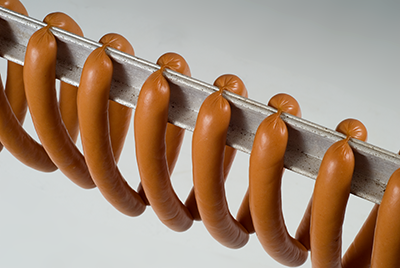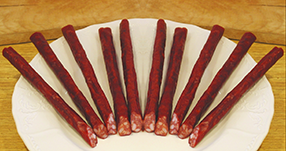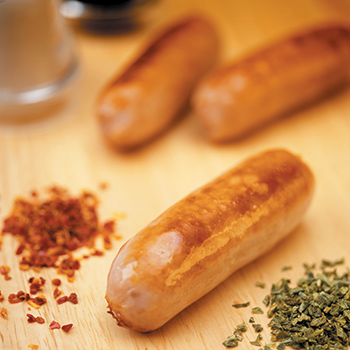Collagen Casings were created and developed in the late 1920’s in response to the market demand. In the 1960’s edible collagen casings were introduced, similar to the animal casings but possessing the uniformity of a manufactured product. Their uniformity allowed for predictable, consistent drying of sausages and controlled cooking of specialty items.The clarity of the fresh collagen casing enhances the bloom while standing up to the most rigorous stuffing and twisting operations.
Fresh sausage collagen casings, as with processed collagen casings, ensures uniformity helping to improve productivity, tenderness, a natural look but with precise size and weight control, enhanced eye-appeal, excellent portion control while giving you the bite and texture you are looking for in your product.
Are you thinking you might want to make a change from a natural casing.
Find a way to make portion packaging more attainable and less frustrating?
Processed collagen casings give you strand length, adds efficiency to your operation, and ensures uniformity; helping to improve your bottom line. Processed collagen is available in a variety of sizes and are offered in clear, red and smoke colored.
Processed collagen casings give you an increased production rate, less down time and clean up, increased stuffing yield, excellent portion control, resembles a natural casing and longer shelf life. Get that look, bite and texture your consumer is after.
Your customer is always looking for that extra juicy sausage whether you are grilling, baking, broiling or any form of cooking. Let collagen casings be your versatile casing.

- Breakfast Sausage Links
- Fresh Italian Sausage
- Fresh Bratwurst
- Fresh Kielbasa
You may want to think about using fresh sausage collagen.
Quality Casing Co., Inc. is only a call away to assist you with your fresh collagen casing supplies.

- Beef Sticks
- Smoked Sausage
- Pepperoni
- Kielbasa
- Hot Dogs
Try collagen, you be glad you did!
Available sizes on collagen casings:
| Stuffing Diameter | Packaging | PRODUCT EXAMPLES |
| 15-23mm | Caddies/Master Cases | Beefstick Collagen Casings |
| 19-32mm | Caddies/Master Cases | Fresh Collagen Casings |
| 24-34mm | Caddies/Master Cases | Processed Collagen Casings |
What is collagen and how is it produced?
- The corium layer (splits) of USDA—approved cattle hides is extruded from between the grain (hair) layer and the fat and muscle layer.
- The hide consists essentially of collagen. Protein and water are chopped and mixed with lactic acid and cellulose fibers causing them to swell and form a slurry.
- The acid-swollen slurry is deaerated under vacuum, and then homogenized and filtered to tease the collagen fibers apart.
- The resultant slurry is again deaerated and stored in chilled tanks.
- It is then extruded through a die with counter rotating sleeves, which weave the collagen fibers together as they pass through the die.
- The slurry, which is now in the form of a casing, passes directly into a concentrated coagulating solution of an inorganic salt.
- The casing is chemically treated in the process machine to cross-link the fibers and give the casing integrity. The casing is then washed and plasticized with glycerin.
- The casing is then dried, partially rehumidified and wound on reels.
- The reels are taken to the shirring area where the collagen casing is shirred on machines similar to the type commonly used in the shirring of regenerated cellulose casings.

Now that you know the production aspects, why not try them on for size. Your specialized product, not to mention your customers, will be happy you did.
